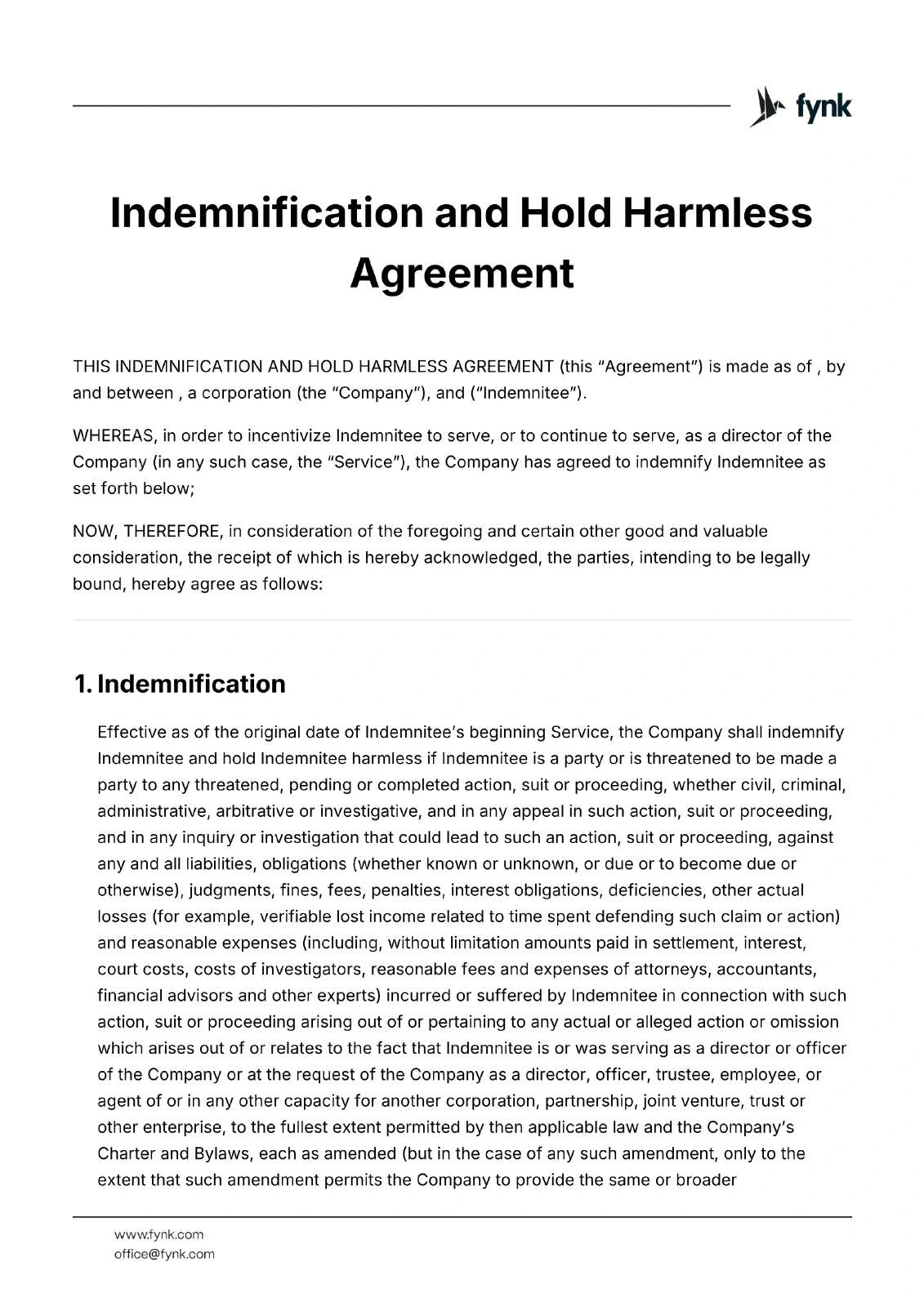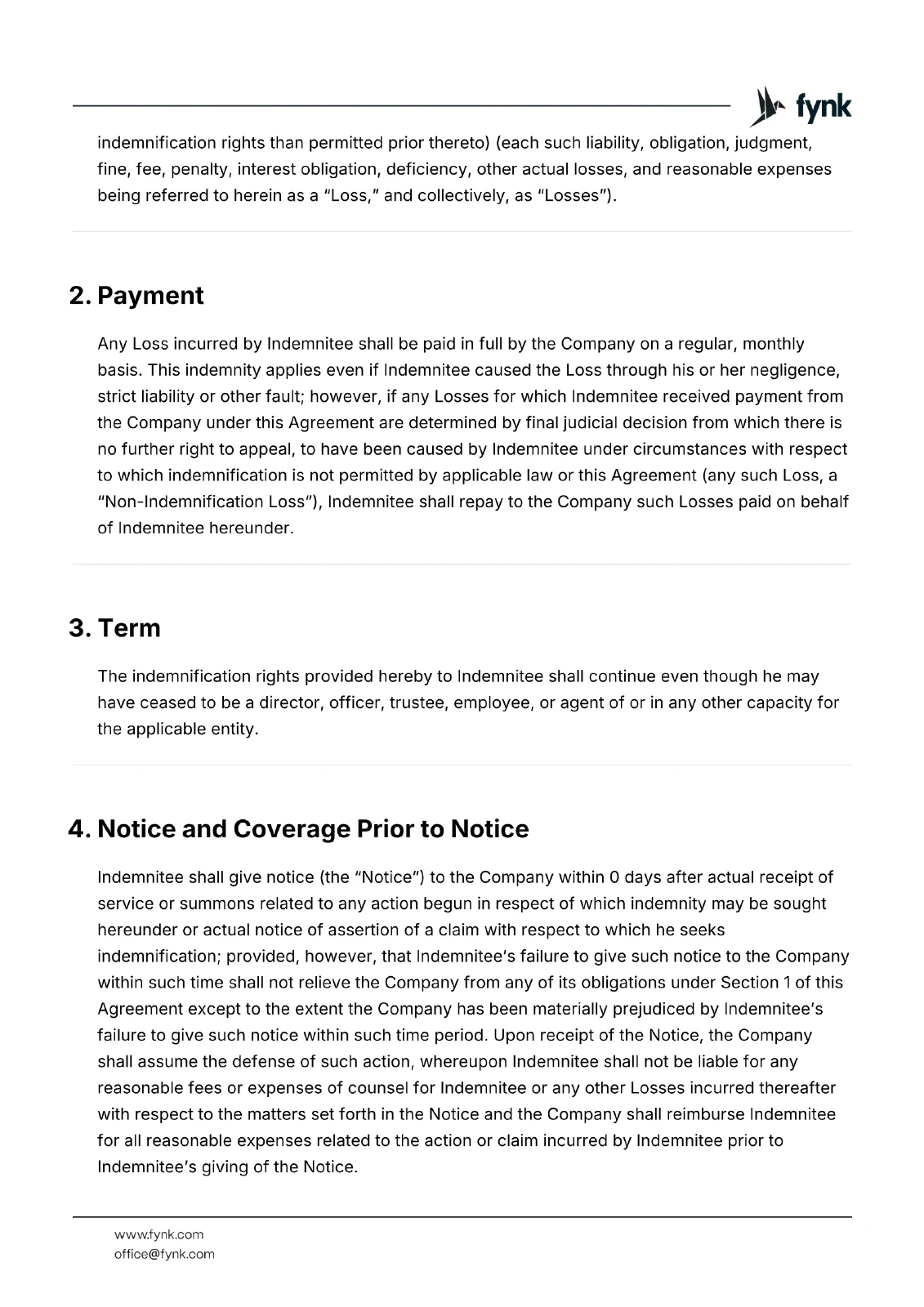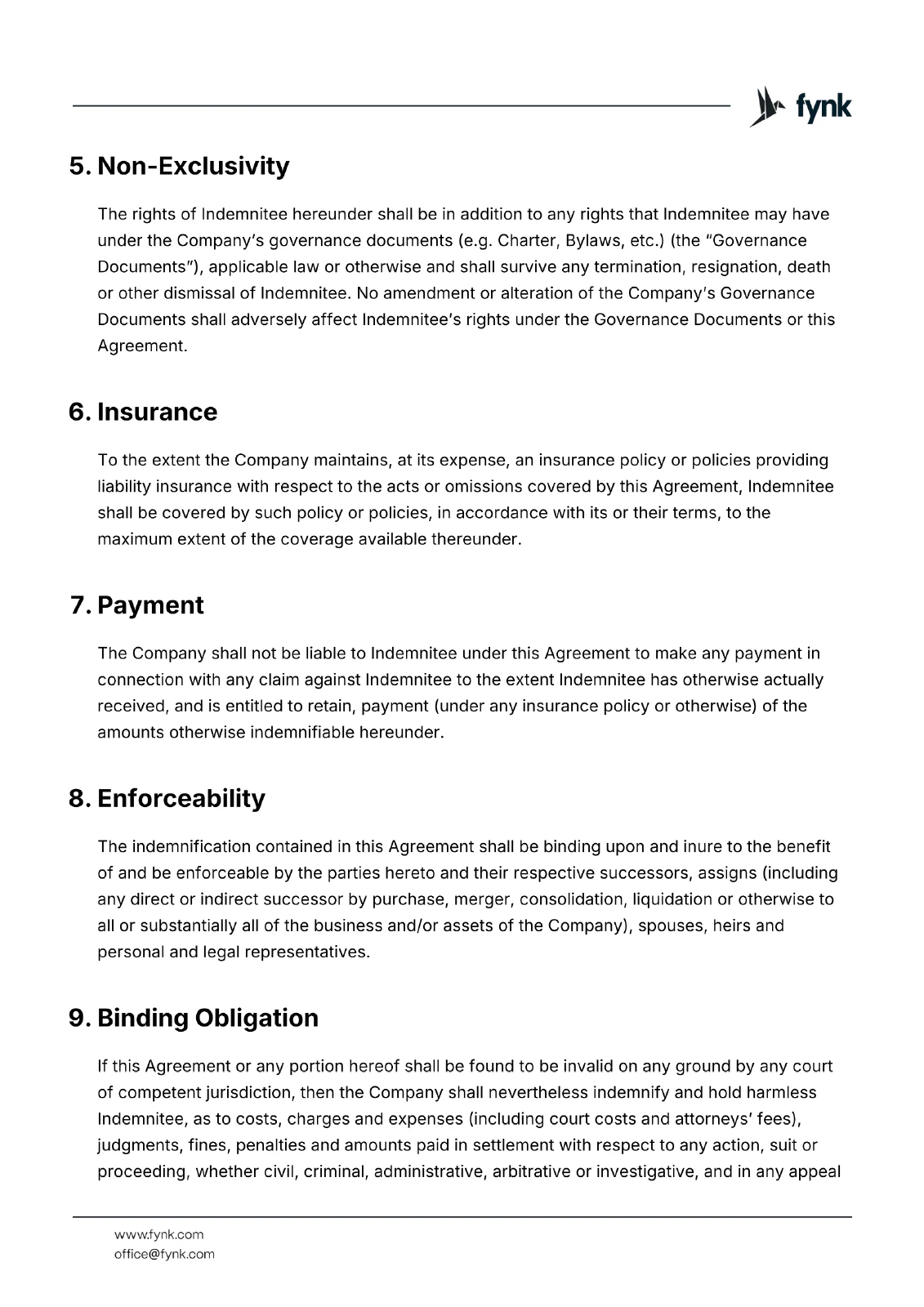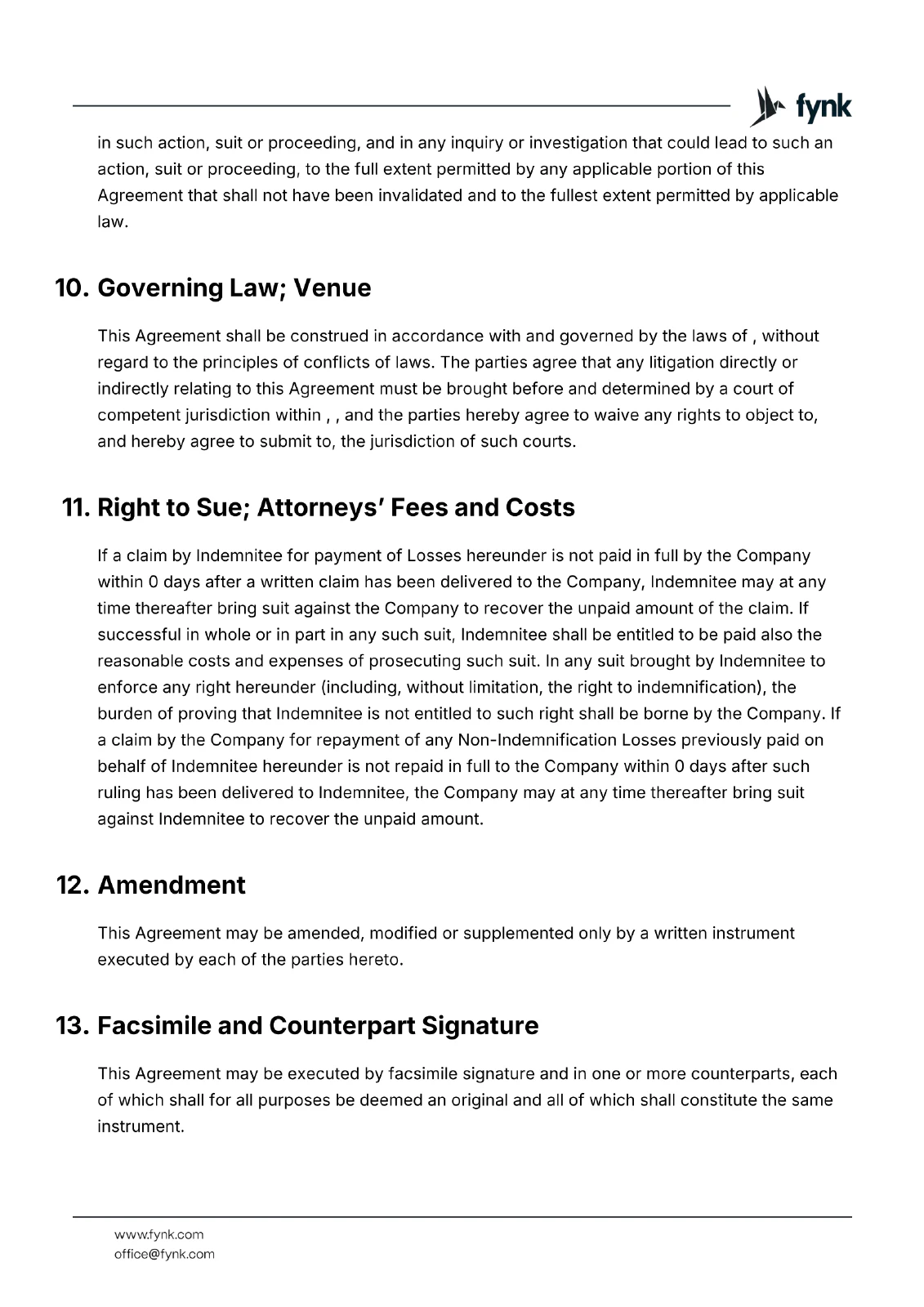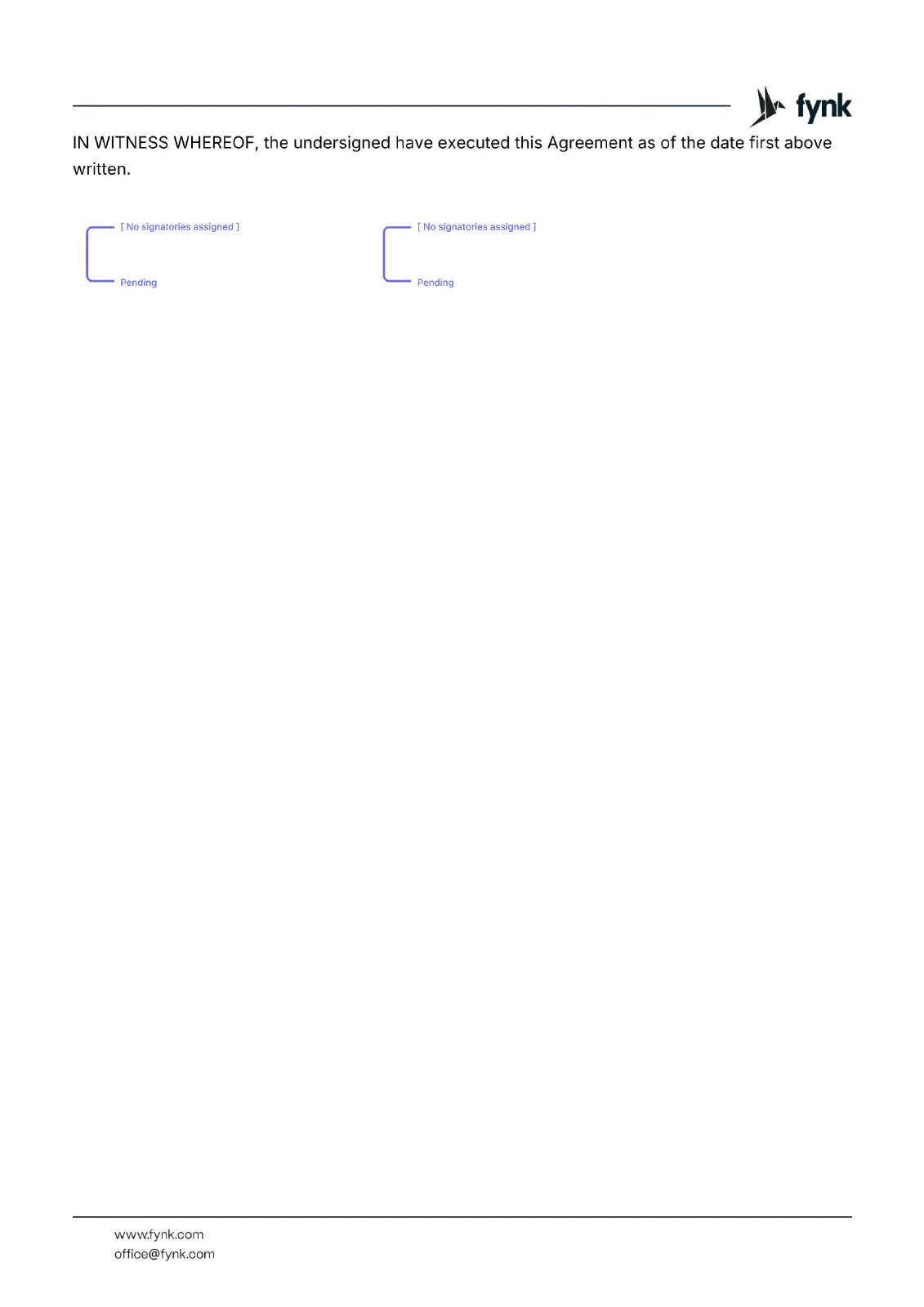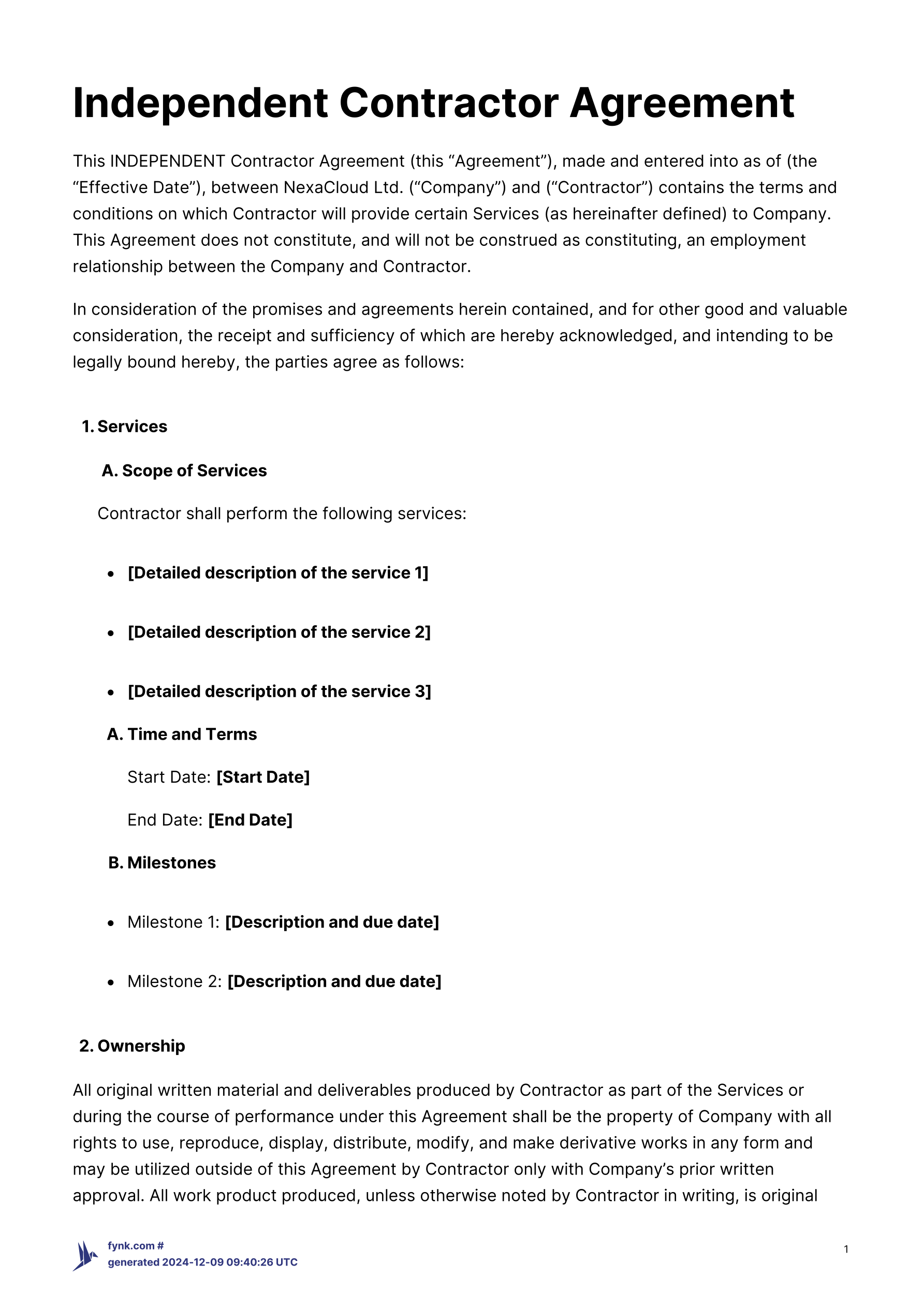Indemnification and Hold Harmless Agreement
THIS INDEMNIFICATION AND HOLD HARMLESS AGREEMENT (this “Agreement”) is made as of , by and between , a corporation (the “Company”), and (“Indemnitee”).
WHEREAS, in order to incentivize Indemnitee to serve, or to continue to serve, as a director of the Company (in any such case, the “Service”), the Company has agreed to indemnify Indemnitee as set forth below;
NOW, THEREFORE, in consideration of the foregoing and certain other good and valuable consideration, the receipt of which is hereby acknowledged, the parties, intending to be legally bound, hereby agree as follows:
Indemnification
Effective as of the original date of Indemnitee’s beginning Service, the Company shall indemnify Indemnitee and hold Indemnitee harmless if Indemnitee is a party or is threatened to be made a party to any threatened, pending or completed action, suit or proceeding, whether civil, criminal, administrative, arbitrative or investigative, and in any appeal in such action, suit or proceeding, and in any inquiry or investigation that could lead to such an action, suit or proceeding, against any and all liabilities, obligations (whether known or unknown, or due or to become due or otherwise), judgments, fines, fees, penalties, interest obligations, deficiencies, other actual losses (for example, verifiable lost income related to time spent defending such claim or action) and reasonable expenses (including, without limitation amounts paid in settlement, interest, court costs, costs of investigators, reasonable fees and expenses of attorneys, accountants, financial advisors and other experts) incurred or suffered by Indemnitee in connection with such action, suit or proceeding arising out of or pertaining to any actual or alleged action or omission which arises out of or relates to the fact that Indemnitee is or was serving as a director or officer of the Company or at the request of the Company as a director, officer, trustee, employee, or agent of or in any other capacity for another corporation, partnership, joint venture, trust or other enterprise, to the fullest extent permitted by then applicable law and the Company’s Charter and Bylaws, each as amended (but in the case of any such amendment, only to the extent that such amendment permits the Company to provide the same or broader indemnification rights than permitted prior thereto) (each such liability, obligation, judgment, fine, fee, penalty, interest obligation, deficiency, other actual losses, and reasonable expenses being referred to herein as a “Loss,” and collectively, as “Losses”).
Payment
Any Loss incurred by Indemnitee shall be paid in full by the Company on a regular, monthly basis. This indemnity applies even if Indemnitee caused the Loss through his or her negligence, strict liability or other fault; however, if any Losses for which Indemnitee received payment from the Company under this Agreement are determined by final judicial decision from which there is no further right to appeal, to have been caused by Indemnitee under circumstances with respect to which indemnification is not permitted by applicable law or this Agreement (any such Loss, a “Non-Indemnification Loss”), Indemnitee shall repay to the Company such Losses paid on behalf of Indemnitee hereunder.
Term
The indemnification rights provided hereby to Indemnitee shall continue even though he may have ceased to be a director, officer, trustee, employee, or agent of or in any other capacity for the applicable entity.
Notice and Coverage Prior to Notice
Indemnitee shall give notice (the “Notice”) to the Company within 0 days after actual receipt of service or summons related to any action begun in respect of which indemnity may be sought hereunder or actual notice of assertion of a claim with respect to which he seeks indemnification; provided, however, that Indemnitee’s failure to give such notice to the Company within such time shall not relieve the Company from any of its obligations under Section 1 of this Agreement except to the extent the Company has been materially prejudiced by Indemnitee’s failure to give such notice within such time period. Upon receipt of the Notice, the Company shall assume the defense of such action, whereupon Indemnitee shall not be liable for any reasonable fees or expenses of counsel for Indemnitee or any other Losses incurred thereafter with respect to the matters set forth in the Notice and the Company shall reimburse Indemnitee for all reasonable expenses related to the action or claim incurred by Indemnitee prior to Indemnitee’s giving of the Notice.
Non-Exclusivity
The rights of Indemnitee hereunder shall be in addition to any rights that Indemnitee may have under the Company’s governance documents (e.g. Charter, Bylaws, etc.) (the “Governance Documents”), applicable law or otherwise and shall survive any termination, resignation, death or other dismissal of Indemnitee. No amendment or alteration of the Company’s Governance Documents shall adversely affect Indemnitee’s rights under the Governance Documents or this Agreement.
Insurance
To the extent the Company maintains, at its expense, an insurance policy or policies providing liability insurance with respect to the acts or omissions covered by this Agreement, Indemnitee shall be covered by such policy or policies, in accordance with its or their terms, to the maximum extent of the coverage available thereunder.
Payment
The Company shall not be liable to Indemnitee under this Agreement to make any payment in connection with any claim against Indemnitee to the extent Indemnitee has otherwise actually received, and is entitled to retain, payment (under any insurance policy or otherwise) of the amounts otherwise indemnifiable hereunder.
Enforceability
The indemnification contained in this Agreement shall be binding upon and inure to the benefit of and be enforceable by the parties hereto and their respective successors, assigns (including any direct or indirect successor by purchase, merger, consolidation, liquidation or otherwise to all or substantially all of the business and/or assets of the Company), spouses, heirs and personal and legal representatives.
Binding Obligation
If this Agreement or any portion hereof shall be found to be invalid on any ground by any court of competent jurisdiction, then the Company shall nevertheless indemnify and hold harmless Indemnitee, as to costs, charges and expenses (including court costs and attorneys’ fees), judgments, fines, penalties and amounts paid in settlement with respect to any action, suit or proceeding, whether civil, criminal, administrative, arbitrative or investigative, and in any appeal in such action, suit or proceeding, and in any inquiry or investigation that could lead to such an action, suit or proceeding, to the full extent permitted by any applicable portion of this Agreement that shall not have been invalidated and to the fullest extent permitted by applicable law.
Governing Law; Venue
This Agreement shall be construed in accordance with and governed by the laws of , without regard to the principles of conflicts of laws. The parties agree that any litigation directly or indirectly relating to this Agreement must be brought before and determined by a court of competent jurisdiction within , , and the parties hereby agree to waive any rights to object to, and hereby agree to submit to, the jurisdiction of such courts.
Right to Sue; Attorneys’ Fees and Costs
If a claim by Indemnitee for payment of Losses hereunder is not paid in full by the Company within 0 days after a written claim has been delivered to the Company, Indemnitee may at any time thereafter bring suit against the Company to recover the unpaid amount of the claim. If successful in whole or in part in any such suit, Indemnitee shall be entitled to be paid also the reasonable costs and expenses of prosecuting such suit. In any suit brought by Indemnitee to enforce any right hereunder (including, without limitation, the right to indemnification), the burden of proving that Indemnitee is not entitled to such right shall be borne by the Company. If a claim by the Company for repayment of any Non-Indemnification Losses previously paid on behalf of Indemnitee hereunder is not repaid in full to the Company within 0 days after such ruling has been delivered to Indemnitee, the Company may at any time thereafter bring suit against Indemnitee to recover the unpaid amount.
Amendment
This Agreement may be amended, modified or supplemented only by a written instrument executed by each of the parties hereto.
Facsimile and Counterpart Signature
This Agreement may be executed by facsimile signature and in one or more counterparts, each of which shall for all purposes be deemed an original and all of which shall constitute the same instrument.
IN WITNESS WHEREOF, the undersigned have executed this Agreement as of the date first above written.

